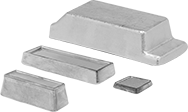Filter by
Material
Melting Temperature
Approximate Width
Approximate Thickness
Approximate Length
Approximate Weight
DFARS Specialty Metals
Export Control Classification Number (ECCN)
REACH
RoHS
Casting Metals

Melt and pour these alloys into molds to create metal parts and prototypes.
Tin-base babbitt is used to cast bearings for high-speed, high-wear applications and can withstand heavy, sustained loads. It has a higher melting temperature than lead-base babbitt.
Tin-Base Babbitt
Material Composition | Approximate | |||||||||
|---|---|---|---|---|---|---|---|---|---|---|
| Melting Temperature, °F | Tin | Antimony | Copper | Thick. | Wd. | Lg. | Wt., lbs. | Each | ||
| 669° | 89% | 7% | 4% | 1 1/2" | 2" | 5 1/2" | 4 1/2 | Sheet and Bar | 0000000 | 0000000 |

























